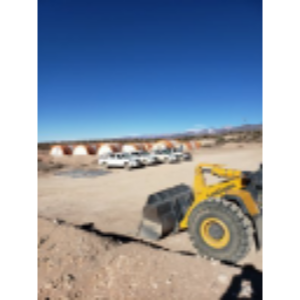Turmalina Expands Mineralization at Veta Rica and Discovers New Mineralized Zones
VANCOUVER, British Columbia, Nov. 15, 2023 (GLOBE NEWSWIRE) -- Turmalina Metals Corp. (“Turmalina”, or the “Company”; TBX-TSXV, TBXXF-OTCQX, 3RI-FSE) is pleased to announce results from continued surface work at the Company’s 403 km2 San Francisco project located in the prolific mining province of San Juan, Argentina (the “Project” or “San Francisco”). Following the recent discovery of the high-grade epithermal gold vein system at Veta Rica (see announcement dated October 10th, 2023) field work has focused on mapping and sampling the surrounding area. This surface work has discovered multiple mineralized veins in the immediate vicinity of Veta Rica and has also discovered two new zones of similar epithermal mineralization located approximately two and four kilometres northwest of Veta Rica: the Machete and Destino systems respectively.
Highlights of Veta Rica Target Area
- Recent mapping has traced the Veta Rica epithermal vein for over 700 m on surface with surface widths of 1 to 6 m: Surface gold assays are typically between 0.9 and 2.7 g/t Au but with higher grade zones of up to 56.6 g/t Au.
- This mapping has also identified multiple mineralized veins adjacent to, and parallel with, the Veta Rica vein (Figures 2, 3 & 4) with similar average grades (typically 0.45 to 4 g/t Au). Detailed sampling is underway to identify potential high-grade zones in these newly discovered veins.
- Recently announced drill holes at Veta Rica returned:
- 4.4 m @ 6.4 g/t Au; SFDH-078 from 36.6 m.
- Including 0.5 m @ 28.6 g/t Au from 36.6 m.
- And 0.45 m @ 14.12 g/t Au from 38.85 m.
- 8.75 m @ 3.5 g/t Au; SFDH-079 from 42 m.
- Including 6.0 m @ 4.6 g/t Au from 42 m.
- Including 1.18 m @ 17.9 g/t Au from 42 m.
- 4.4 m @ 6.4 g/t Au; SFDH-078 from 36.6 m.
Highlights of Destino Target Area
- A new system with at least four parallel epithermal quartz veins, and two adjacent breccias, located 3 km northwest of Veta Rica (Figure 2, 7, 8 & 9).
- Initial sampling (56 samples) of the veins, each with over 200 m of strike length, returned similar gold grades to Veta Rica, with 10 samples over 1 g/t Au, up to a maximum of 6.1 g/t Au (Figure 7).
- In the southern portion of the Destino target area, 34 samples taken from a 100 by 130 m breccia pipe (the Tiki-Tiki breccia) returned four samples over 1 g/t, up to a maximum of 22 g/t Au, 227 g/t Ag and
0.9% Pb.
Highlights of Machete Vein zone
- Located between Veta Rica and Destino, 2.7 km northwest of Veta Rica drilling, 3 rock chip samples taken from the Machete epithermal quartz vein returned grades of 1.1 to 2.7 g/t Au and 28 to 170 g/t Ag. Follow up sampling is underway (Figures 2 & 9).
Mr James Rogers, Chief Executive Officer, states:
“After an exciting discovery at Veta Rica, the exploration team quickly went to work and we have now greatly expanded the area of known mineralization at Veta Rica, with the vein traced for over 700 m strike length and several parallel veins identified. Additionally, the team has already identified two new epithermal gold vein and breccia systems at Destino and Machete, with high-grade gold rock chip samples at surface. Turmalina is excited at the opportunity these nearby vein systems represent for our team to add value to our well positioned land package. With these recent discoveries it is becoming clear we have discovered a new epithermal district in this established gold belt, and we look forward to keeping the market informed of our exploration progress over the coming months in what is a very exciting time for the Company.
Figure 1: Regional view northwest showing the block of properties controlled by Turmalina Metals with the drill target locations drilled in this campaign and the previously drilled San Francisco Breccia.
The Project area is located within a known epithermal gold belt. The nearest such epithermal gold system is located at Austral Gold’s Casposo mine, 70 road kilometres south of the Veta Rica discovery. Casposo produced 283,000 oz of gold and 9.6 M oz of silver with average grades of 4.8 g/t Au and 183 g/t Ag between 2011 and 2015 and another 32,000 oz of gold and 3 M oz of silver between 2017 and 2019 before the mill was placed back into care and maintenance (2017-2019 Austral Gold Annual Reports). The historic epithermal district of Castano Viejo is located 20 km to the south of Veta Rica (Figure 1). Castaño Viejo was operated by the National Lead Company S.A between 1956 and 1964, with an estimated reserve of 614,000t @
Drill planning and budgeting are underway for a 4,000 m diamond drilling program focussed on testing and expanding targets within the Destino and Veta Rica target areas. Surface works are continuing with crews focussed on additional surface sampling and mapping. After receiving results of the current sampling program, areas will be ranked and selected for trenching and construction of access roads prior to drilling.
Figure 2: Geologic map showing veins, breccias and gold in rock chip samples across the Veta Rica, Destino and Machete target areas. Mapping and sampling have identified multiple mineralised veins at Veta Rica, Machete and Destino, and mapping is currently underway to define a potential new target in the top right of the map (21 g/t Au).
Figure 3: Veta Rica Surface map and sections showing drill holes and distribution of rock chip sampling of the Veta Rica vein. Sampling 300 m west of the drill pads has returned grades of up to 27 g/t Au, while samples 700 m west of the drilling has returned grades of up to 2.7 g/t Au.
Figure 4: Drone photo looking northwest showing 700 m strike length of Veta Rica, select surface rock chip samples and established drill pads. The Veta Rica vein remains open to both the west and, in the foreground, to the east where it passes under shallow cover.
Figure 5: Photo of core in hole SFDH-078 and hand sample from outcrop at the extension along strike of Veta Rica: Brecciated crystalline quartz surrounded by intense sericite alteration with iron oxide and jarosite, formed after weathering of sulphides.
Figure 6: Examples of high-grade gold mineralisation in core samples and from an outcrop along strike from drilling at Veta Rica. Mineralisation is hosted in crystalline quartz (commonly brecciated) with intense sericite alteration and hematite-goethite-jarosite, formed by the weathering of sulphides.
Figure 7: Plan map of the newly discovered Destino vein and breccia system showing distribution of gold grades in rock chip samples that returned up to 22.2 g/t Au. Gold mineralisation is hosted within both epithermal quartz veins and adjacent quartz-tourmaline breccias.
Figure 8: Photos of an epithermal vein at Destino. Mineralization is hosted in epithermal quart veins (locally banded) and within intensely brecciated and sericite-altered granodiorite and diorite that hosted abundant hematite-goethite-jarosite veinlets.
Figure 9: Machete epithermal vein zone. The veins and gold mineralization are hosted in strongly sericite-altered granodiorite (a), with quartz veinlets (b) and portions brecciated with green/grey silica and iron oxides and jarosite. Float in the area includes samples of finely banded silica and iron oxide (d) and breccia with matrix of crystalline quartz (comb texture) with fragments of finally banded silica and iron oxides after sulphides (e), both textures typical of epithermal veins.
About The San Francisco Project
The 40,340 ha San Francisco project is located in the pro-mining province of San Juan, Argentina, a country where there are currently 12 operating mines, 5 in construction and 20 in pre-feasibility/feasibility stage. The project benefits from well-developed infrastructure and is 130 km northeast of the regional capital San Juan.
The San Francisco Project was assembled around, and includes, one of the highest-grade tourmaline breccias of the same name. The land position at San Francisco was expanded in 2022 and now includes multiple mineralized targets including more than 60 breccias, intrusion-related gold and epithermal vein-type targets.
Initial exploration efforts at San Francisco were focussed on breccia mineralization. Through the Company’s extensive exploration work, led by Chico Azevedo, the project has greatly expanded into highly prospective areas containing a number of veins, intrusion-related, porphyry and breccia targets.
While the San Francisco breccia pipe remains one of the highest-grade tourmaline Cu-Au breccia pipes ever discovered (see select results in Table 1) the Company is most excited about the exploration potential for high-grade gold-silver and polymetallic vein types and other mineralization styles. The Veta Rica discovery exemplifies the style of epithermal mineralization commonly found in the district.
Turmalina has developed an operational centre in the town of Villa Nueva, where the local community welcomes new exploration efforts in the region.
Turmalina has several option agreements to acquire
| Table 1: Selected highlight of previous Company drilling at the San Francisco Breccia Pipe | ||||||||||||||||
| Hole ID | Target | From (m) | To (m) | Interval (m) | Au (g/t) | Ag (g/t) | Cu (%) | Pb (%) | Zn (%) | AuEq g/t | CuEq % | |||||
| SFDH-012 | SF BX | 12 | 121 | 109 | 4.94 | 109 | 1.13 | 0.23 | 0.06 | 8.00 | 5.49 | |||||
| SFDH-039 | SF BX | 397.7 | 470 | 72.3 | 0.71 | 100 | 3.47 | 0.31 | 0.69 | 7.07 | 4.85 | |||||
| SFDH-038 | SF BX | 0 | 81 | 81 | 2.33 | 63.94 | 0.23 | 0.23 | 0.38 | 3.50 | 2.40 | |||||
| SFDH-011 | SF BX | 25 | 108 | 83 | 4.4 | 82 | 0.43 | 0.74 | 0.52 | 6.09 | 4.18 | |||||
| SFDH-011 | SF BX | 27 | 68 | 41 | 7.03 | 91 | 0.51 | 0.23 | 0.02 | 8.96 | 6.14 | |||||
*Intersections are not true widths and additional drilling and geological modelling of the mineralized zones in the breccia pipes is required to determine the true widths of the drill hole intersections. Intersections are selected based on a 0.5 g/t Au or
On Behalf of the Company,
Mr James Rogers Chief Executive Officer and Director.
Website: turmalinametals.com
Address: #1507 - 1030 West Georgia St, Vancouver, BC V6E 3V7.
For Investor Relations enquiries, please contact Highland Contact at +1 833 923 3334 (toll free) or via info@turmalinametals.com.
Statements
About Turmalina Metals and our projects: Turmalina Metals is a TSXV-listed exploration company focused on developing our portfolio of high-grade gold-copper-silver projects in South America. Our focus is on tourmaline breccias, a deposit style overlooked by many explorers. Turmalina Metals is led by a team responsible for multiple gold-copper-silver discoveries who are highly experienced in this deposit style. Our projects are characterised by open high-grade mineralization on established mining licenses that present compelling drill targets. The principal project held by Turmalina is the San Francisco project in San Juan, Argentina. For further information on the San Francisco Project, refer to the technical report entitled “NI43-101 Technical Report San Francisco Copper Gold Project, San Juan Province, Argentina” dated November 17, 2019 under the Corporation’s profile at www.sedar.com. Turmalina is also exploring the Chanape project in Peru. For further information on Chanape please refer to the technical report “National Instrument 43-101 Technical Report on the Chanape Gold-Silver-Copper Project” dated July 5, 2022 under the Corporation’s profile at www.sedar.com.
Sampling and Analytic procedure: Turmalina Metals follows systematic sampling and analytical protocols which exceed industry standards and are summarized below.
For the collection of rock chip samples, geologists choose the best place to collect a sample based on local geology, point of interest, oxidization on surface, and other discerning features. With the aid of geological hammer, samples are broken from the outcrop and cleaned of vegetation and/or organic material. Sample descriptions are recorded and the UTM coordinate taken with a hand-held GPS. Samples are placed in a thick plastic bag and a pre-numbered sample tag placed in the bag. Sample mass is typically in the range of 3 to 5 kilograms. The outside of the bag is marked with permanent marker for easy reference. An aluminium tag with the sample number is placed at the location from where the sample was collected.
Turmalina Metals independently inserts certified control standards, coarse field blanks and duplicates into the sample stream to monitor data quality (‘QA/QC’ samples). These QA/QC samples are inserted “blindly” to the laboratory in the sample sequence prior to departure from the Turmalina Metals core storage facilities. For rock chip samples 4 QA/QC samples are inserted into each 80-sample dispatch: 1 blank sample, and 3 commercially-prepared standards.
The assay results for the QA/QC samples are checked and verified by the project geologist and the Qualified Person. All such QA/QC assay results from sample dispatches reported in this news release have been found to be within acceptable industry limits, and the Qualified Person is not aware of any sampling, recovery or any other factors that could materially affect the accuracy or reliability of the data.
Qualified Person: The scientific, technical and analytical data contained in this news release pertaining to the San Francisco and Chanape projects has been reviewed and approved by Dr. Rohan Wolfe, Technical Advisor, MAIG, who serves as the Qualified Person (QP) under the definition of National Instrument 43-101.
Forward Looking Statement: This news release contains certain "forward-looking statements" within the meaning of such statements under applicable securities law. Forward-looking statements are frequently characterized by words such as "anticipates", "plan", "continue", "expect", "project", "intend", "believe", "anticipate", "estimate", "may", "will", "potential", "proposed", "positioned" and other similar words, or statements that certain events or conditions "may" or "will" occur. These statements are only predictions. Various assumptions were used in drawing the conclusions or making the projections contained in the forward-looking statements throughout this news release. Forward-looking statements are based on the opinions and estimates of management at the date the statements are made and are subject to a variety of risks (including those risk factors identified in the Corporation’s prospectus dated November 21, 2019) and uncertainties and other factors that could cause actual events or results to differ materially from those projected in the forward-looking statements. The Corporation is under no obligation, and expressly disclaims any intention or obligation, to update or revise any forward-looking statements, whether as a result of new information, future events or otherwise, except as expressly required by applicable law.
Figures accompanying this announcement are available at:
https://www.globenewswire.com/NewsRoom/AttachmentNg/af7df1f7-4e2c-4d1d-8ecc-9115807f9341
https://www.globenewswire.com/NewsRoom/AttachmentNg/d93214b3-ff8f-4c09-99f9-87976645831d
https://www.globenewswire.com/NewsRoom/AttachmentNg/931719cc-a3ed-41b1-bdf0-c19768bc4117
https://www.globenewswire.com/NewsRoom/AttachmentNg/425e1ca0-6a47-4ea9-b2ac-98840e7036c4
https://www.globenewswire.com/NewsRoom/AttachmentNg/941bc07b-1de5-4bab-92fa-d2c7ce8249c0
https://www.globenewswire.com/NewsRoom/AttachmentNg/37579f0f-527f-4059-b86c-0164a6f9234d
https://www.globenewswire.com/NewsRoom/AttachmentNg/4b8651d6-c6b6-4fcd-891f-f7ad8c908c0d
https://www.globenewswire.com/NewsRoom/AttachmentNg/46ab988c-16cd-4a65-8f10-262f14d5f2c9
https://www.globenewswire.com/NewsRoom/AttachmentNg/22463aa7-caa3-4d53-b3f7-db20bdec530e








